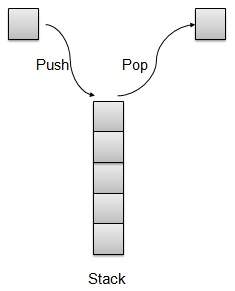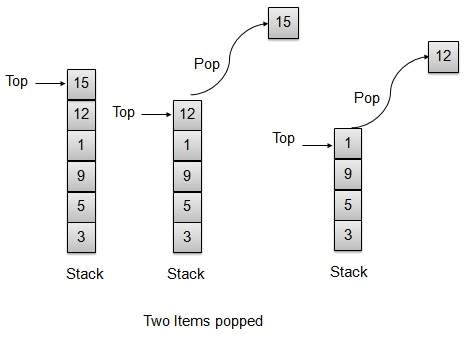
- DSA 使用 Java 教程
- 使用 Java 的 DSA - 主页
- 使用 Java 的 DSA - 概述
- 使用 Java 的 DSA - 环境设置
- 使用 Java 的 DSA - 算法
- 使用 Java 的 DSA - 数据结构
- 使用 Java 的 DSA - 数组
- 使用 Java 的 DSA - 链表
- 使用 Java 的 DSA - 双向链表
- 使用 Java 的 DSA - 循环链表
- 使用Java的DSA - 堆栈内存溢出
- DSA - 解析表达式
- 使用 Java 的 DSA - 队列
- 使用 Java 的 DSA - 优先级队列
- 使用 Java 的 DSA - 树
- 使用 Java 的 DSA - 哈希表
- 使用 Java 的 DSA - 堆
- 使用 Java 的 DSA - 图
- 使用 Java 的 DSA - 搜索技术
- 使用 Java 的 DSA - 排序技术
- 使用 Java 的 DSA - 递归
- 使用 Java 的 DSA 有用资源
- 使用 Java 的 DSA - 快速指南
- 使用 Java 的 DSA - 有用资源
- 使用 Java 的 DSA - 讨论
使用Java的DSA - 堆栈内存溢出
概述
堆栈是一种只允许在一端对数据进行操作的数据结构。它只允许访问最后插入的数据。堆栈也称为 LIFO(后进先出)数据结构,Push 和 Pop 操作以这样的方式相关:只有最后压入(添加到堆栈)的项目才能弹出(从堆栈中删除)。
堆栈表示

在本文中,我们将使用数组来实现 Stack。
基本操作
以下是堆栈的两个主要操作。
Push - 将一个元素压入栈顶。
Pop - 从堆栈顶部弹出一个元素。
以下是堆栈支持的更多操作。
Peek - 获取堆栈顶部的元素。
isFull - 检查堆栈是否已满。
isEmpty - 检查堆栈是否为空。
推送操作
每当一个元素被推入堆栈时,堆栈就会将该元素存储在存储的顶部,并递增顶部索引以供以后使用。如果存储已满,通常会显示错误消息。

// push item on the top of the stack
public void push(int data) {
if(!isFull()){
// increment top by 1 and insert data
intArray[++top] = data;
}else{
System.out.println("Cannot add data. Stack is full.");
}
}
流行操作
每当要从堆栈中弹出一个元素时,堆栈都会从存储顶部检索该元素,并减少顶部索引以供以后使用。

// pop item from the top of the stack
public int pop() {
// retrieve data and decrement the top by 1
return intArray[top--];
}
堆栈实现
堆栈.java
package com.tutorialspoint.datastructure;
public class Stack {
private int size; // size of the stack
private int[] intArray; // stack storage
private int top; // top of the stack
// Constructor
public Stack(int size){
this.size = size;
intArray = new int[size]; //initialize array
top = -1; //stack is initially empty
}
// Operation : Push
// push item on the top of the stack
public void push(int data) {
if(!isFull()){
// increment top by 1 and insert data
intArray[++top] = data;
}else{
System.out.println("Cannot add data. Stack is full.");
}
}
// Operation : Pop
// pop item from the top of the stack
public int pop() {
//retrieve data and decrement the top by 1
return intArray[top--];
}
// Operation : Peek
// view the data at top of the stack
public int peek() {
//retrieve data from the top
return intArray[top];
}
// Operation : isFull
// return true if stack is full
public boolean isFull(){
return (top == size-1);
}
// Operation : isEmpty
// return true if stack is empty
public boolean isEmpty(){
return (top == -1);
}
}
演示程序
StackDemo.java
package com.tutorialspoint.datastructure;
public class StackDemo {
public static void main (String[] args){
// make a new stack
Stack stack = new Stack(10);
// push items on to the stack
stack.push(3);
stack.push(5);
stack.push(9);
stack.push(1);
stack.push(12);
stack.push(15);
System.out.println("Element at top of the stack: " + stack.peek());
System.out.println("Elements: ");
// print stack data
while(!stack.isEmpty()){
int data = stack.pop();
System.out.println(data);
}
System.out.println("Stack full: " + stack.isFull());
System.out.println("Stack empty: " + stack.isEmpty());
}
}
如果我们编译并运行上面的程序,那么它将产生以下结果 -
Element at top of the stack: 15 Elements: 15 12 1 9 5 3 Stack full: false Stack empty: true